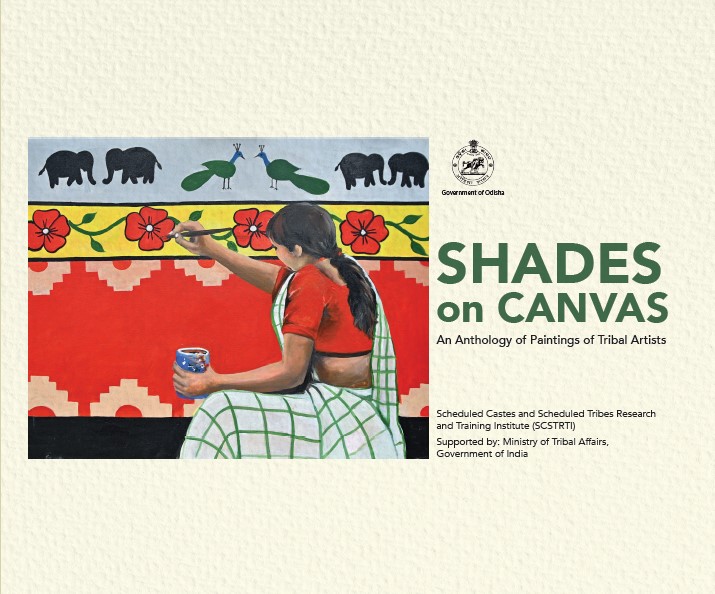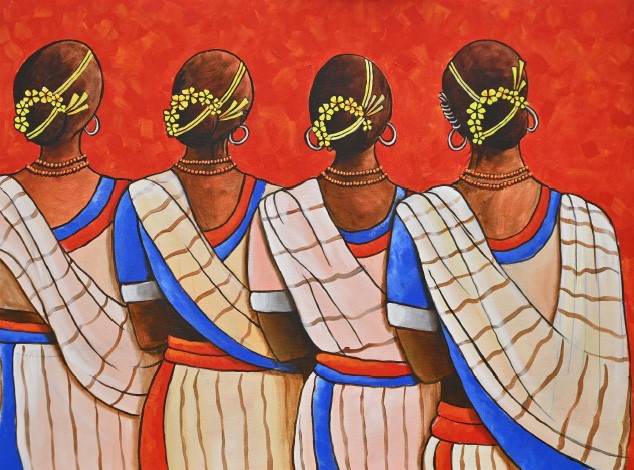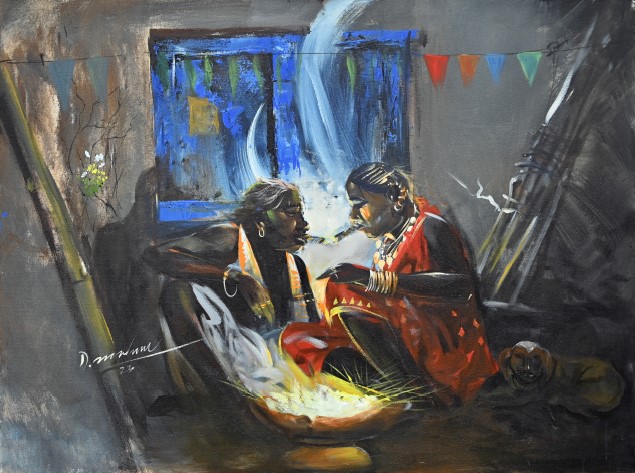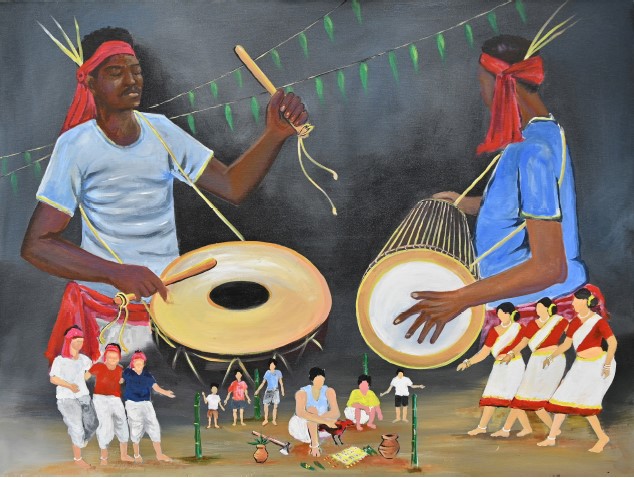OdishaPlus Bureau

Let’s have a journey through the primordial landscapes and lifestyle of the tribal communities of Odisha through a coffee table book – ‘Shades on Canvas: An Anthology of Paintings of Tribal Artists’, published by the Scheduled Castes and Scheduled Tribes Research and Training Institute (SCSTRTI), Bhubaneswar. The journey is important for every reader who will go through the book as it unfolds the primeval culture and the beauty of nature in the surroundings of tribal villages located in the hinterlands of the state.
The content of the book was evolved in a three-day workshop conducted at SCSTRTI Campus during 16th and 18th November, 2023 in which 26 budding tribal artists had joined and gave wings to their imagination. Whereas most of them are currently students in art colleges or graduated in fine art and crafts, or have been pursuing a career as an artist.
Incidentally, Dasha Murmu, the oldest of the lot has painted in mix-media a Kondh tribal couple sharing their happiness by smoking Pika or rolled Dhungia leaves together in a cold night during the ‘Chaiti Parab’ festival. He has used spatula to paint acrylic and brush to use water colour to get the desired impact in his painting. In fact, he is the most well-known tribal artist of Odisha. He is felicitated with Gold Medal at Madurai, Silver Medal at West Bengal, Giridhari Gamango Award at Bhubaneswar, Parab Samman at Koraput and Madei Samman at Nabarangapur, etc.
Similarly, about ten such tribal young artists had participated in the workshop those who were born after 2000, and the youngest of them all were born in 2004 and are still pursuing their studies in art colleges. These student artis are Akshaya Kumar Bankira (Kolha), Jiban Mandingi (Kondh) and Fudan Majhi (Santal). The other seven born post 2000 are Bablu Majhi Krutarth Mohan Majhi and Upamanyu Kuanra (Gond), Dhirendra Haiburu (Ho), Iswar Sabar (Shabar), Laxman Majhi (Kondh) and Rabindra Bargam (Kutia).

The rest fifteen artists are Anuradha Pradhan, Layu Majhi and Priyanka Dehuri (Kondh), Binodini Singh (Koda), Shibaram Nayak and Kamal Lochan Gomango (Saora), Basen Tudu, Narendra Kumar Majhi, Sunil Kumar Hembram, Pinu Majhi and Rama Chandra Majhi (Santal), Premanand Budek (Sahara), Subash Sodi (Koya), Subham Purty (HO Munda) and Trinath Majhi (Paraja).
Jiban Mandingi has narrated the story of ‘Baliyatra’ festival prevalent in the Kondhmal district. This festival takes place during the yielding season of crops when the tribal people are in happy and in a mood of celebration. At the same time the tribal community worship various gods and goddesses including mother nature. To signify that the artist has painted a woman taking basket-full of crops to home while a man is juxtaposed beating the drum in a happy mode.
Whereas Fudan Majhi in his mix-media painting has narrated the welcoming of guests upon their arrival during the marriage ceremony of Santali Community. While the male members of the family play ‘Tumda’ and ‘Tamak’, a female member holding the sacred ‘Kalasa’ or earthen-pot welcome the guests to their home, Ashok Kumar Bankia’s painting delineates the details of ‘Maghe Parba’ which is being celebrated by the ‘Kolha’ tribal group in the months of Pousha and Magha.
One of the attention-grabbing paintings is by Anuradha Pradhan who has also participated in the State Lalit Kala Art Exhibition. Since she belongs to the ‘Kondh’ tribal group of the Kandhamala district, she has painted their community dancing during the worship of Dharani Penu. She has painted the dancing Kondh women from the rear so as to highlight their clothing and ornamentation on the neck, earlobe and head; like Gala Mali, Kana Fula, KeshafulaGuchhia, etc. She has used varied colors to enhance those elements from the striped Sarees to various ornaments.

Basen Tudu has visually narrated the ‘ItutBapla’ or the marriage ritual of the ‘Santal’ community – this ritual takes place at the threshold of the girl’s residence. Since in Santali culture the bride is considered as Laxmi, or Goddess of abundance, and so she is kept inside a ‘Tokei’ or bamboo basket in her room from where she is brought out by her brothers to get her married to the groom.
Whereas Subham Purty in his mix media on canvas has narrated the way a ‘Ho Munda’ tribal woman ties the child on her back while travelling places to work, Shibaram Nayak has painted how a typical Saora mother puts her child into sleep on her arms.
As the tribal people believes in the sanctity of sacred space and elements to invoke their gods and goddesses, artists like Pinu Majhi, Iswar Sabar, Kamal Lochan Gomango, Krutarth Mohan Majhi, Laxman Majhi, Layu Majhi and Narendra Kumar Majhi, etc. have painted on those themes. Most striking among those paintings is by Layu Majhi who has symbolically narrated the ‘Toki-mara’ ritual in order to worship ‘Dharani Penu’. Whereas Narendra has painted ‘Jaher Than’, the sacred space where the Santali people worship their god ‘Maranjuru’, Laxman Majhi has narrated the sanctity of the ‘Totem Poles’ of the Dongria Kondh tribal community.
Since festivals are integral part of the tribal communities, many artists of the workshop have visually narrated about their own festivities – dancing and playing rhythm instruments are inevitable part by the tribal people during their festivals which constitutes their traditions and rituals. Artists like Bablu Majhi, Akshay Kumar Bankira, Bablu Majhi and Phudan Majhi, etc. have visually narrated that aspect in their paintings. Subash Sodi has symbolically represented the ‘Malyabanta’ festival of the Koya community by just painting their headgear.

Rama Chandra Majhi has painted a young beautiful Santali woman holding a cat moves with her delicate steps in the surrounding of nature near her village. The young woman is in her traditional Santali attire looks innocent and fragile, yet her curiosity laden eyes ready to explore her surroundings. Thus, Rama Chandra has aesthetically narrated the beauty of a tribal young girl to quench his artistic thirst.
This coffee table book really gives a scope to the reader to have a tour through the varied aspects of the tribal life in Odisha. Therefore, Indramani Tripathy, Director of SCSTRTI in the preface of the book has aptly said, “In these pictures, our young Tribal Artists have poured their hearts into capturing moments from the natural world, spiritual realms, village life, architectural wonders, cultural treasures, joyful activities, and the artistic essence of tribal life. With their skilled hands, they reveal captivating stories of indigenous communities, highlighting their customs and artistic expressions”.






















